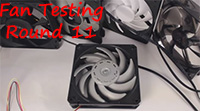I was in need of picking up another gallon of distilled water at Wal-mart today, and decided to stop by a few more stores and do a quick evaluation of water purity of a few different brands. In addition, I wanted to better understand the importance of water quality and scale since there is no data on how water quality changes when run in a loop. I’ve read or heard a few people say that store bought distilled water just isn’t good or reliable enough and that you really need to buy ultra pure water. I have used regular distilled water in non-plated water cooling loops for years now and have even run tapwater in a loop for over a year now just for this nagging myth being spread about. Since I bought my own water purity meter, I now had the tools needed to see for myself and wanted to share my findings.
This test is sponsored by martinsliquidlab.org…:)
Water Quality Meters
First, let’s look at the meters. It doesn’t break the bank to buy these, I spent under $100 to buy them both:

I initially started testing both electrical conductivity as well as PH, but after a while realized that the PH was generally the same. It’s hard to measure with such little conductivity, but all the samples were within 6.5-7.5 PH which is neutral.
The conductivity meter is an HM Digital COM-100
http://www.tdsmeter.com/products/com100.html
SPECIFICATIONS
EC Range: 0 – 9990 µS; 0 – 9.99 mS
TDS Range: 0 – 8560 ppm (mg/L); 0 – 8.56 ppt
Temperature Range: 0-80 °C; 32-176 °F
Resolution: 0-99: 0.1 µS/ppm/mS/ppt; 100-999: 1 µS/ppm; 1000-9990: 10 µS/ppm. Temp. resolution is 0.1 °C/F
Accuracy: +/- 2%
EC to TDS Conversion Factor: Non-linear conversions for KCl, 442TM or NaCl solutions, selected by the user.
Calibration: Digital calibration by push button.
Probe: Detachable platinum electrodes
Housing: IP-67 Waterproof (submersible; floats)
Power source: 3 x 1.5V button cell batteries (included) (model 357A)
Dimensions: 18.5 x 3.4 x 3.4 cm (7.3 x 1.3 x 1.3 inches)
Weight: 90.7g (3.2 oz)The COM-100 meter is calibrated with a 1413 µS solution.
The meter comes factory calibrated with a 1413 uS solution and appeared to be reading fairly accurately, so I proceeded to test with that factory calibration.
Electrical conductivity or EC is a commonly used indicator to measure water purity. While conductivity itself isn’t the only measurement goal, total dissolved solids (TDS) in ppm (Parts per million) are also routinely converted from this number. To keep it simple, I’m just measuring the conductivity in this test and including a conversion table that was included with the meter to TDS if you are so inclined. Distilled waters typically should be better than 10uS where municipal water systems could be as high as 500-800uS. In water cooling we have had all sorts of numbers thrown out there with suggestions that grocery store distilled wasn’t good enough. In addition there was not any data in regards to how quickly this water becomes ionized in the loop which is important when considering the relevance of purity.
So with that….let’s get on with some measurements..:)

I think its worth noting that Distilled water absorbs CO2 from the air VERY fast. This is probably why when you put it through your rad where there is no air it stopped raising its conductivity.
It is also important to note the temperature of water plays a MASSIVE part in its conductivity, the warmer the water the higher the conductivity so inside a hot loop the conductivity will plummet.
Good to know, thanks!
Our Silver Springs (FL) store brand spring water was 411 uS/cm.
minerals add conductivty. Not a bad thing for taste